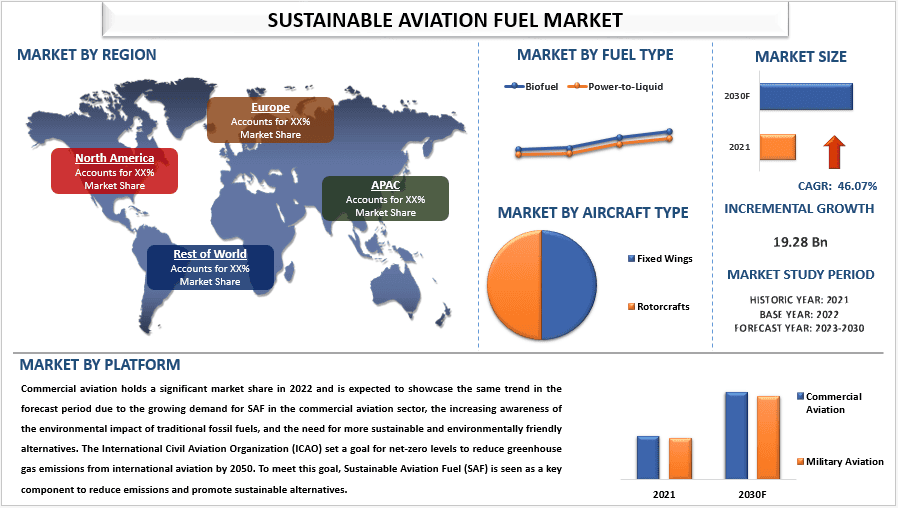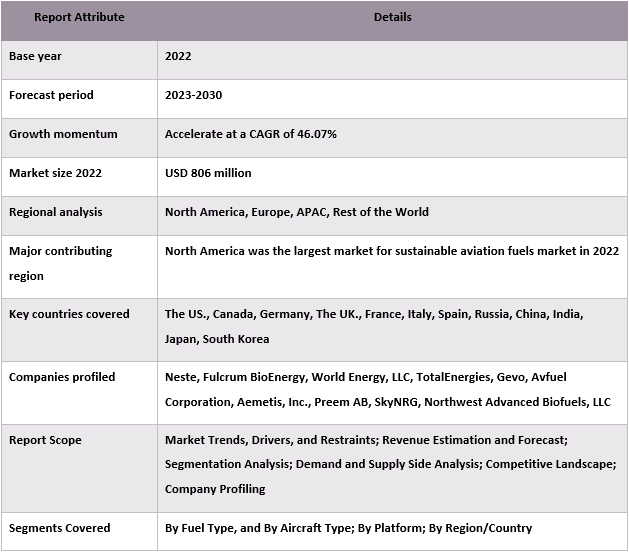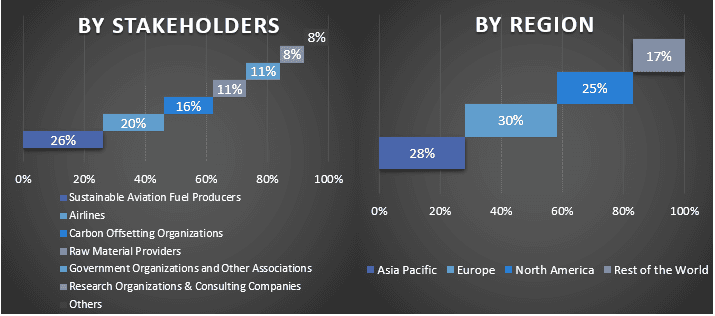- Inicio
- Acerca de nosotros
- Industria
- Servicios
- Leyendo
- Contáctenos
Mercado de combustible de aviación sostenible: análisis actual y previsión (2023-2030)
Énfasis en el tipo de combustible (biocombustible y Power-to-Liquid); Tipo de aeronave (ala fija y aeronaves de rotor); Plataforma (aviación comercial y aviación militar); y Región/País

Se espera que el Mercado Mundial de Combustible de Aviación Sostenible alcance los USD 20 088,69 millones en 2030, creciendo a una CAGR del 46,07%. La demanda de combustible de aviación sostenible (SAF) ha aumentado significativamente en los últimos años, impulsada por las políticas y regulaciones gubernamentales para reducir las emisiones de carbono, la competitividad de los costes, el aumento de la capacidad de producción de los fabricantes y la accesibilidad en todo el mundo. La mayor conciencia de los impactos ambientales de la aviación ha impulsado la demanda de combustibles de aviación sostenibles (SAF). Para mitigar la contribución del sector al cambio climático, varios gobiernos han adoptado ciertas medidas, siendo el SAF un factor esencial en estos esfuerzos. Por ejemplo, la Unión Europea se ha fijado el objetivo de lograr cero emisiones netas de la aviación internacional para 2050, y muchas naciones han implementado modelos de fijación de precios del carbono para fomentar la adopción de tecnologías de bajas emisiones de carbono. Varias aerolíneas importantes se han comprometido a comprar combustible de aviación sostenible (SAF) y han establecido asociaciones con productores como Emirates Airlines y la empresa conjunta BP-Qantas para facilitar la producción de SAF a partir de aceite de cocina usado.
Algunos de los principales actores que operan en el mercado son Neste, Fulcrum BioEnergy, World Energy, LLC, TotalEnergies, Gevo, Avfuel Corporation, Aemetis, Inc., Preem AB, SkyNRG, Northwest Advanced Biofuels, LLC. Estos actores han realizado varias fusiones y adquisiciones junto con asociaciones para facilitar a los clientes productos/tecnologías innovadores y de alta tecnología.
Perspectivas presentadas en el informe
“Entre los tipos de combustible, el segmento de biocombustibles dominó el mercado en 2022.”
Según el tipo de combustible, el mercado se divide en biocombustible, combustible de hidrógeno y energía a líquido. El segmento de biocombustibles dominó el mercado en 2022 y se espera que muestre la misma tendencia en el período de pronóstico. Los biocombustibles se crean a partir de fuentes de biomasa renovables como residuos agrícolas, algas o incluso basura. Estos combustibles emiten significativamente menos gases de efecto invernadero durante la combustión que los combustibles fósiles tradicionales, lo que ayuda a reducir los efectos ambientales adversos de la aviación. Además, los biocombustibles se pueden mezclar con combustibles fósiles tradicionales en diversas proporciones, lo que permite a los operadores reducir su dependencia de los combustibles fósiles de forma incremental sin causar perturbaciones operativas significativas. Muchos países han establecido objetivos ambiciosos para reducir las emisiones de gases de efecto invernadero del sector de la aviación, y los biocombustibles se consideran una parte crucial de este esfuerzo. Por ejemplo, la Unión Europea ha ordenado que todos los vuelos comerciales utilicen únicamente combustibles de aviación sostenibles (SAF) para el año 2020. Además, la Junta de Recursos del Aire de California ha implementado un objetivo de uso del 10% de SAF en California para 2020. Estas regulaciones están proporcionando un impulso convincente para que las aerolíneas y otras partes interesadas de la aviación incorporen biocombustibles en sus prácticas.
“Entre los tipos de aeronaves, el segmento de alas fijas tiene una importante cuota de mercado en 2022.”
Según el tipo de aeronave, el mercado se bifurca en alas fijas y aeronaves de rotor. Las alas fijas tienen una importante cuota de mercado en 2022 y se espera que muestren la misma tendencia en el período de pronóstico debido a que las aeronaves de ala fija se utilizan más comúnmente para vuelos de larga distancia, que requieren más combustible y, por lo tanto, más SAF. Además, se espera que el desarrollo de aeronaves de ala fija más eficientes y respetuosas con el medio ambiente, como el Airbus A220 y el Boeing 787 Dreamliner, también impulse la demanda de SAF en el mercado de ala fija. Además, el entorno regulatorio para SAF también es más favorable para las aeronaves de ala fija. Por ejemplo, la Administración Federal de Aviación (FAA) se ha fijado el objetivo de reducir las emisiones de gases de efecto invernadero de la aviación al 80% por debajo de los niveles de 2005 para 2050. Además, los entornos regulatorios favorecen las aeronaves de ala fija, como el objetivo de la FAA de reducir las emisiones de gases de efecto invernadero y el objetivo de la UE del 10% de combustible para aviones de fuentes sostenibles para 2030, lo que probablemente impulse una mayor adopción de SAF en aeronaves de ala fija.
“América del Norte fue el mercado más grande para el mercado de combustibles de aviación sostenibles en 2022.”
El mercado norteamericano de combustible de aviación sostenible domina el mercado y se espera que se comporte de la misma manera debido a la adopción temprana del SAF. En los últimos años, la demanda de combustible de aviación sostenible (SAF) ha experimentado un rápido aumento en América del Norte debido a los requisitos reglamentarios y al deseo de reducir las emisiones de gases de efecto invernadero del sector de la aviación. En 2020, la Agencia de Protección Ambiental de los Estados Unidos (EPA) emitió una norma final que exige a los aeropuertos que proporcionen combustible de aviación de autoservicio (SAF) a los operadores de aeronaves de aviación general antes de agosto de 2023. De manera similar, en 2017, la Autoridad Canadiense de Seguridad del Transporte Aéreo (CATSA) introdujo nuevas regulaciones que exigen a los aeropuertos que ofrezcan SAF a los operadores comerciales antes de diciembre de 2020. Estas regulaciones han creado un mandato para que los aeropuertos instalen bombas de SAF y atraigan a proveedores para que se establezcan en la región. Además, la reducción de las emisiones de gases de efecto invernadero es un paso crucial, la aviación contribuye con el 2,5% de las emisiones mundiales de CO2, lo que la convierte en un instrumento para combatir el cambio climático. El combustible de aviación sostenible (SAF) reduce las emisiones sin comprometer el rendimiento y está ganando el apoyo de las aerolíneas y los aeropuertos para ser más sostenibles.
Q1: ¿Cuál es el tamaño actual del mercado y el potencial de crecimiento del mercado mundial de combustible de aviación sostenible?
R: El mercado mundial de combustible de aviación sostenible se valoró en USD 806 millones en 2022 y se espera que crezca a una CAGR del 46,07% durante el período de pronóstico (2023-2030).
Q2: ¿Cuáles son los factores impulsores del crecimiento del mercado mundial de combustible de aviación sostenible?
R: Los principales factores que contribuyen al crecimiento del mercado incluyen las políticas y regulaciones gubernamentales para reducir las emisiones de carbono, la competitividad de los costes, el aumento de la capacidad de producción de los fabricantes y la accesibilidad en todo el mundo.
Q3: ¿Qué segmento tiene la mayor cuota del mercado mundial de combustible de aviación sostenible por tipo de combustible?
R: El segmento de biocombustibles tiene la mayor cuota del mercado mundial de combustible de aviación sostenible.
Q4: ¿Cuáles son las tecnologías y tendencias emergentes en el mercado mundial de combustible de aviación sostenible?
R: Las técnicas avanzadas de mezcla son las tecnologías y tendencias emergentes en el mercado mundial de combustible de aviación sostenible.
Q5: ¿Qué región dominará el mercado mundial de combustible de aviación sostenible?
R: Se espera que América del Norte domine el mercado durante el período de pronóstico.
Q6: ¿Quiénes son los actores clave que operan en el mercado mundial de combustible de aviación sostenible?
R: Neste, Fulcrum BioEnergy, World Energy, LLC, TotalEnergies, Gevo, Avfuel Corporation, Aemetis, Inc., Preem AB, SkyNRG, Northwest Advanced Biofuels, LLC.
Cobertura del informe del mercado de combustible de aviación sostenible

Razones para comprar este informe:
- El estudio incluye el dimensionamiento del mercado y el análisis de pronóstico validados por expertos clave autenticados de la industria.
- El informe presenta una revisión rápida del rendimiento general de la industria de un vistazo.
- El informe cubre un análisis en profundidad de los pares prominentes de la industria con un enfoque principal en las finanzas comerciales clave, las carteras de productos, las estrategias de expansión y los desarrollos recientes.
- Examen detallado de los impulsores, las restricciones, las tendencias clave y las oportunidades que prevalecen en la industria.
- El estudio cubre exhaustivamente el mercado en diferentes segmentos.
- Análisis profundo a nivel regional de la industria.
Opciones de personalización:
El mercado mundial de combustible de aviación sostenible se puede personalizar aún más según los requisitos o cualquier otro segmento de mercado. Además de esto, UMI entiende que puede tener sus propias necesidades comerciales, por lo tanto, no dude en contactarnos para obtener un informe que se adapte completamente a sus requisitos.
Tabla de contenido
Metodología de Investigación para el Análisis del Mercado de Combustible de Aviación Sostenible (2023-2030)
El análisis del mercado histórico, la estimación del mercado actual y la previsión del mercado futuro del mercado mundial de combustible de aviación sostenible fueron los tres pasos principales emprendidos para crear y analizar la adopción de combustibles de aviación sostenibles en las principales regiones del mundo. Se llevó a cabo una exhaustiva investigación secundaria para recopilar las cifras históricas del mercado y estimar el tamaño del mercado actual. En segundo lugar, para validar estas ideas, se tomaron en consideración numerosos hallazgos y supuestos. Además, también se realizaron exhaustivas entrevistas primarias con expertos de la industria en toda la cadena de valor del mercado mundial de combustible de aviación sostenible. Tras la suposición y la validación de las cifras del mercado a través de entrevistas primarias, empleamos un enfoque de arriba hacia abajo/de abajo hacia arriba para pronosticar el tamaño total del mercado. Posteriormente, se adoptaron métodos de desglose del mercado y de triangulación de datos para estimar y analizar el tamaño del mercado de los segmentos y subsegmentos de la industria a la que pertenece. A continuación, se explica la metodología detallada:
Análisis del Tamaño Histórico del Mercado
Paso 1: Estudio en Profundidad de Fuentes Secundarias:
Se llevó a cabo un estudio secundario detallado para obtener el tamaño histórico del mercado de combustible de aviación sostenible a través de fuentes internas de la empresa, como informes anuales y estados financieros, presentaciones de resultados, comunicados de prensa, etc., y fuentes externas, incluidos revistas, noticias y artículos, publicaciones gubernamentales, publicaciones de la competencia, informes del sector, bases de datos de terceros y otras publicaciones creíbles.
Paso 2: Segmentación del Mercado:
Después de obtener el tamaño histórico del mercado de combustible de aviación sostenible, llevamos a cabo un análisis secundario detallado para recopilar información histórica del mercado y compartirla para diferentes segmentos y subsegmentos para las principales regiones. Los principales segmentos incluidos en el informe son el tipo de combustible, el tipo de aeronave y la plataforma. Además, se realizaron análisis a nivel de país para evaluar la adopción general de modelos de prueba en esa región.
Paso 3: Análisis de Factores:
Después de adquirir el tamaño histórico del mercado de diferentes segmentos y subsegmentos, llevamos a cabo un análisis de factores detallado para estimar el tamaño actual del mercado de combustible de aviación sostenible. Además, realizamos un análisis de factores utilizando variables dependientes e independientes, como el tipo de combustible, el tipo de aeronave y la plataforma del mercado de combustible de aviación sostenible. Se llevó a cabo un análisis exhaustivo de los escenarios de oferta y demanda teniendo en cuenta las principales asociaciones, fusiones y adquisiciones, la expansión empresarial y los lanzamientos de productos en el sector del mercado de combustible de aviación sostenible en todo el mundo.
Estimación y Previsión del Tamaño Actual del Mercado
Tamaño Actual del Mercado: Basándonos en la información práctica de los 3 pasos anteriores, llegamos al tamaño actual del mercado, los actores clave en el mercado mundial de combustible de aviación sostenible y las cuotas de mercado de los segmentos. Todos los porcentajes de participación y los desgloses del mercado necesarios se determinaron utilizando el enfoque secundario mencionado anteriormente y se verificaron a través de entrevistas primarias.
Estimación y Previsión: Para la estimación y previsión del mercado, se asignaron ponderaciones a diferentes factores, incluidos los impulsores y las tendencias, las restricciones y las oportunidades disponibles para las partes interesadas. Después de analizar estos factores, se aplicaron técnicas de previsión relevantes, es decir, el enfoque de arriba hacia abajo/de abajo hacia arriba, para llegar a la previsión del mercado para 2030 para diferentes segmentos y subsegmentos en los principales mercados a nivel mundial. La metodología de investigación adoptada para estimar el tamaño del mercado abarca:
- El tamaño del mercado de la industria, en términos de ingresos (USD) y la tasa de adopción del mercado de combustible de aviación sostenible en los principales mercados a nivel nacional.
- Todos los porcentajes de participación, divisiones y desgloses de los segmentos y subsegmentos del mercado.
- Actores clave en el mercado mundial de combustible de aviación sostenible en términos de productos ofrecidos. Además, las estrategias de crecimiento adoptadas por estos actores para competir en el mercado de rápido crecimiento.
Validación del Tamaño y la Cuota de Mercado
Investigación Primaria: Se llevaron a cabo entrevistas en profundidad con los Líderes de Opinión Clave (KOL) que incluyen a los Ejecutivos de Alto Nivel (CXO/VP, Jefe de Ventas, Jefe de Marketing, Jefe de Operaciones, Jefe Regional, Jefe de País, etc.) en las principales regiones. Los resultados de la investigación primaria se resumieron y se realizó un análisis estadístico para probar la hipótesis establecida. Los aportes de la investigación primaria se consolidaron con los hallazgos secundarios, convirtiendo así la información en información práctica.
División de los Participantes Primarios en Diferentes Regiones

Ingeniería de Mercado
Se empleó la técnica de triangulación de datos para completar la estimación general del mercado y para llegar a cifras estadísticas precisas para cada segmento y subsegmento del mercado mundial de combustible de aviación sostenible, los datos se dividieron en varios segmentos y subsegmentos después de estudiar varios parámetros y tendencias en las áreas de tipo de combustible, tipo de aeronave y plataforma en el mercado mundial de combustible de aviación sostenible.
El objetivo principal del estudio del Mercado de Combustible de Aviación Sostenible
Las tendencias actuales y futuras del mercado mundial de combustible de aviación sostenible se identificaron en el estudio. Los inversores pueden obtener información estratégica para basar su discreción para las inversiones en el análisis cualitativo y cuantitativo realizado en el estudio. Las tendencias actuales y futuras del mercado determinaron el atractivo general del mercado a nivel regional, proporcionando una plataforma para que el participante industrial explote el mercado sin explotar para beneficiarse de una ventaja de ser el primero en actuar. Otros objetivos cuantitativos de los estudios incluyen:
- Analizar el tamaño actual y previsto del mercado de combustible de aviación sostenible en términos de valor (USD). Además, analizar el tamaño actual y previsto del mercado de diferentes segmentos y subsegmentos.
- Los segmentos en el estudio incluyen áreas del tipo de combustible, el tipo de aeronave y la plataforma.
- Definir y analizar el marco regulatorio para el combustible de aviación sostenible
- Analizar la cadena de valor involucrada con la presencia de varios intermediarios, junto con el análisis de los comportamientos de los clientes y la competencia de la industria.
- Analizar el tamaño actual y previsto del mercado de combustible de aviación sostenible para la principal región.
- Los principales países de las regiones estudiadas en el informe incluyen Asia Pacífico, Europa, América del Norte y el resto del mundo
- Perfil de la empresa del mercado de combustible de aviación sostenible y las estrategias de crecimiento adoptadas por los participantes del mercado para mantenerse en el mercado de rápido crecimiento.
- Análisis regional profundo de la industria
Relacionados Informes
Los clientes que compraron este artículo también compraron










